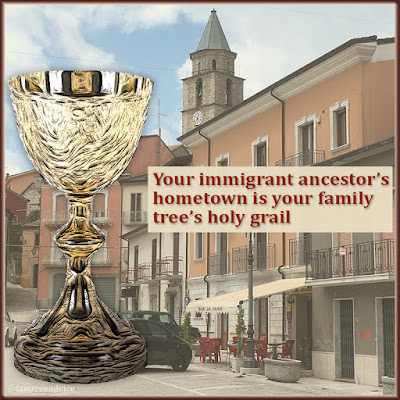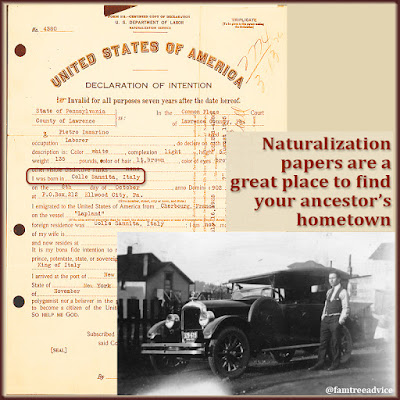The Ellis Island website was my gateway to genealogy. In my early days, I found ship manifests for my 2 grandfathers and other relatives. Then came my Ancestry.com membership, and my next gateway: census records.
What busted my family tree wide open was microfilm. I learned I could go to a Family History Center to view vital records from my Grandpa Leone's hometown. I began a 5-year process of viewing microfilm and typing every fact into a laptop. I have a text file with 29,864 lines of facts from his town's vital records, 1809–1860. I entered those facts into Family Tree Maker software to see how all the families fit together. (If you have an ancestor from Baselice, contact me!)
I'm related to 95% of the town. That research added 15,000 people to my family tree.
But I'm sure I made some errors. I couldn't look at each document again to correct any mistakes. Until 3 years ago. That's when a free website called Antenati published all those vital records and more. Now I have easy access to all the information I transcribed from microfilm in the dark.
Yesterday I ran Family Tree Analyzer to find some of those mistakes. It seems I have a family unit whose birth years don't line up. The 11 children (eleven!) have birth years from the 1760s to the 1780s. The problem is their mother, Antonia Cormano, was too young to have had the first 2 of her children.
And if her birth year is wrong, so are my estimated birth years for her parents and grandparents.
 |
| A routine error check lead me to several generations of one family with age issues. |
The whole mess hinges on the unknown birth year of her first child, Antonio Colucci. Antonio died before 1809 when civil records began. So I can't find his death record easily. I estimated his birth year as 1746—25 years before his eldest child was born. I need to re-examine the marriage records of his descendants to sort things out.
Side note: Italian marriage documents are awesome. They include the bride and groom's birth records. And if any of their parents are dead, you get their death records. If their fathers and grandfathers are dead, you get the grandfathers' death records!
I wanted to learn the true birth year of Antonia's first-born child, Antonio. To find such an early record, I needed to find a male descendant of his who married after he died. Antonio's grandson Michele Antonio Colucci married in 1854. His marriage records did indeed have a death record for his grandfather Antonio. It shows his birth year as 1759, very different from my estimated birth year of 1746. That would help solve my problem with the birth years of Antonia and her ancestors.
But, of course, there's a complication. If Antonio was born in 1759, then he's too young to have had his 2 children born in 1771 and 1775!
The ripple effect of one bad date is enormous! (Are any "Indiana Jones" fans thinking of Harrison Ford's "Bad dates" line right now?)
Maybe Antonio's death record had his age wrong. These mistakes happen all the time. There were no other well-timed marriages that would include the death record I want. But let's say the birth year of 1759 is about right. Biologically, he could have had a child in 1775. So maybe his daughter Angela's birth year of 1771 is wrong. With a child born in 1797, Angela could have been born a bit later.
Her 1832 death record says she was 61 years old, born in 1771. Early birth records from the town rarely include the parents' ages. My only hope of seeing Angela's age apart from on her death record is her daughter's 1811 birth record. Sadly, that record confirms Angela's husband's age, but doesn't mention her age at all.
 |
| It's hard to imagine his age could be off by much when he's only 27 years old. |
Well, that was frustrating. All I can do with what I have is fudge Antonio's birth year a bit and work backwards from there.
The following changes are going to need asterisks:
- I'll push Antonio's birth year back a bit and record it not as 1759, but as 1753. That'd make him an 18-year-old father. That's not common in this town, but it sometimes happened.
- I'll leave his father with his documented birth year of 1735. That'd make him an 18-year-old father, too. Like father, like son.
- Despite what her death record says, I'll change Antonia Cormano's birth year from 1742 to 1735. That'd make her an 18-year-old mother. It's like "Romeo and Juliet" if they'd lived.
- Then I'll follow my usual protocol. For Antonia's parents and grandparents, I'll subtract 25 from the year their child was born. If I change Antonia's birth year to 1735, then her parents were born "Abt 1710", and their parents were born "Abt 1685".
I'm not happy with fudging 2 documented dates, but the pieces didn't fit. I plan to work through this entire extended family, adding documents and sources to Family Tree Maker. If I'm lucky, some overlooked document will turn up with a better clue.
Genealogy, like life, can be messy. Slap on that bandage and keep searching.









